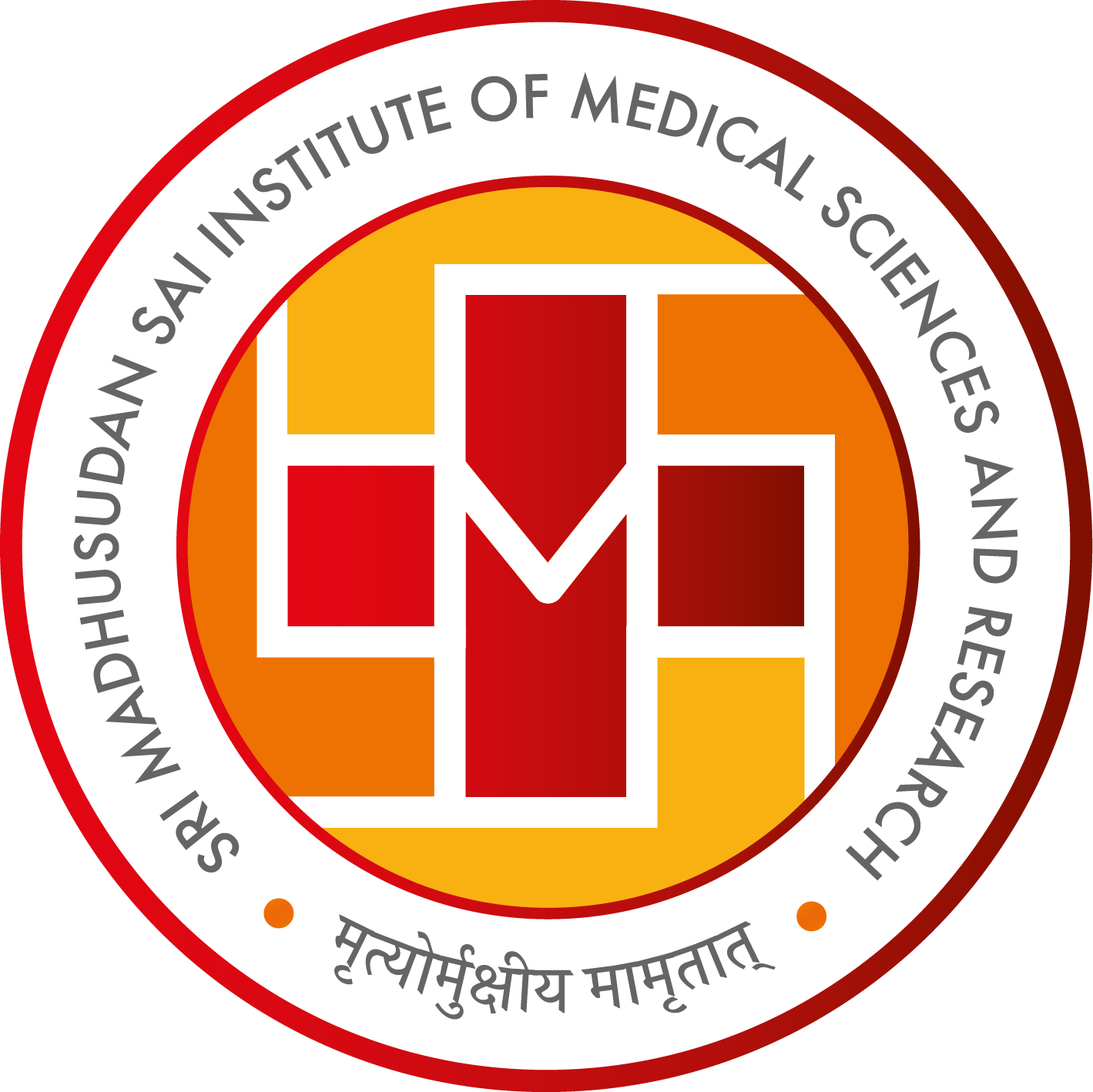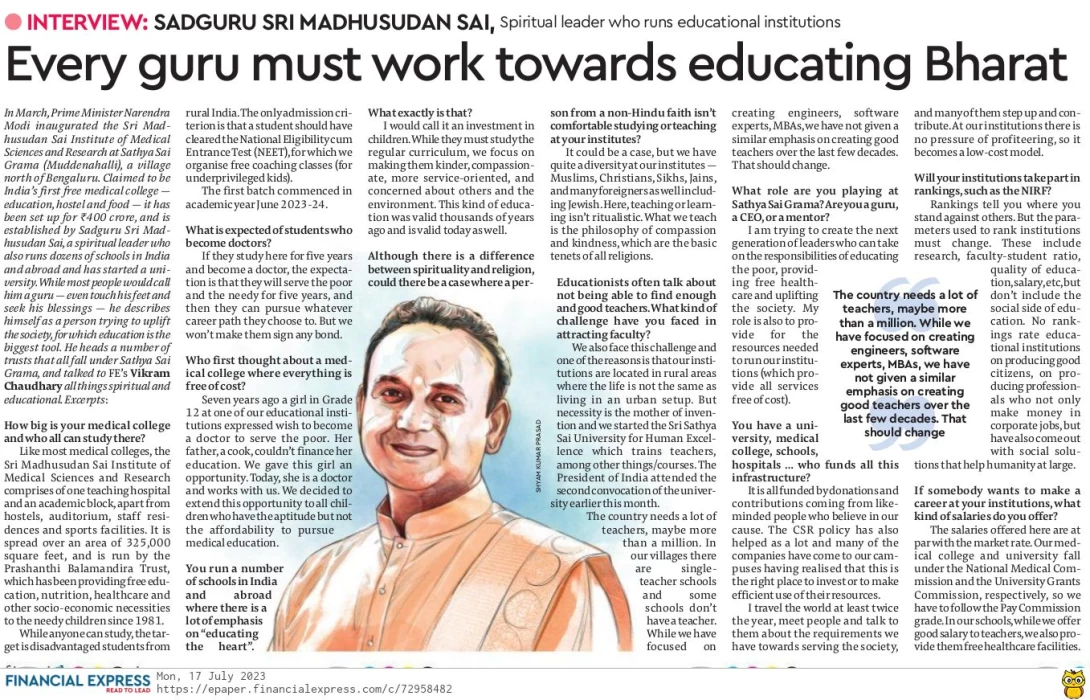Page number 9, Financial Express (17th July 2023): https://epaper.financialexpress.com/m5/3734748/Delhi/July-17-2023#page/9/1
Interview: Sadguru Sri Madhusudan Sai, Spiritual Leader
In March, Prime Minister Narendra Modi inaugurated the Sri Madhusudan Sai Institute of Medical Sciences and Research at Sathya Sai Grama (Muddenahalli), a village north of Bengaluru. Claimed to be India’s first free medical college — education, hostel and food — it has been set up for Rs 400 crore, and is established by Sadguru Sri Madhusudan Sai, a spiritual leader who also runs dozens of schools in India and abroad and has started a university. While most people would call him a guru — even touch his feet and seek his blessings — he describes himself as a person trying to uplift the society, for which education is the biggest tool. He heads a number of trusts that all fall under Sathya Sai Grama, and talked to FE’s Vikram Chaudhary all things spiritual and educational. Excerpts:
How big is your medical college and who all can study there?
Like most medical colleges, the Sri Madhusudan Sai Institute of Medical Sciences and Research comprises of one teaching hospital and an academic block, apart from hostels, auditorium, staff residences and sports facilities. It’s spread over 325,000 square feet, and is run by the Prashanthi Balamandira Trust, which has been providing free education, nutrition, healthcare and other socio-economic necessities to the needy children since 1981.While anyone can study, the target is disadvantaged students from rural India. The only admission criterion is a student should have cleared the National Eligibility cum Entrance Test (NEET), for which we organise free coaching classes (for underprivileged kids). The first batch commenced in academic year June 2023-24.
What is expected of students who become doctors?
If they study here for five years and become a doctor, the expectation is they will serve the poor for five years, and then they can pursue whatever career path they choose to. But we won’t make them sign any bond.
Who first thought about a medical college where everything is free?
Seven years ago, a girl in Grade 12 at our educational institutions expressed wish to become a doctor to serve the poor. Her father, a cook, couldn’t finance her education. We gave this girl an opportunity. Today, she is a doctor and works with us. We decided to extend this opportunity to all children who have the aptitude but not the affordability to pursue medical education.
You run a number of schools in India and abroad where there is a lot of emphasis on “educating the heart”. What exactly is that?
It’s an investment in children. While they must study the regular curriculum, we focus on making them kinder, compassionate, more service-oriented, and concerned about others and the environment. This kind of education was valid thousands of years ago and is valid today as well.
While there is a difference between spirituality and religion, could there be cases where, let’s say, a person from a non-Hindu faith doesn’t feel comfortable studying or teaching at your institutes?
It could be a case, but we have quite a diversity at our institutes — Muslims, Christians, Sikhs, Jains, and many foreigners as well including Jewish. Here, teaching or learning isn’t ritualistic. What we teach is the philosophy of compassion and kindness, which are the basic tenets of all religions.
Educationists often talk about not being able to find enough and good teachers. What kind of challenge have you faced in attracting faculty?
We face this challenge and one of the reasons is that our institutions are located in rural areas where the life is not the same as living in an urban setup. But necessity is the mother of invention and we started the Sri Sathya Sai University for Human Excellence which trains teachers. The President of India attended the second convocation of the university earlier this month. The country needs a lot of teachers, maybe more than a million. In our villages there are single-teacher schools and some schools don’t have a teacher. While we have focused on creating engineers, software experts, MBAs, we have not given a similar emphasis on creating good teachers over the last few decades. That should change.
What role are you playing at Sathya Sai Grama? Are you a guru, a CEO, or a mentor?
I have to wear many hats and I am trying to create the next generation of leaders who can take on these responsibilities of educating the poor, providing free healthcare and uplifting the society. My role is also to provide for the resources needed to run our institutions (which provide all services free of cost).
You have university, college, schools, hospitals … who funds this infrastructure?
It is all funded by donations and contributions coming from like-minded people who believe in our cause. The CSR policy has also helped as a lot and many of the companies have come to our campuses having realised that this is the right place to invest or to make efficient use of their resources.I travel the world at least twice the year, meet people and talk to them about the requirements we have towards serving the society, and many of them step up and contribute. At our institutions there is no pressure of profiteering, so it becomes a low-cost model.
Will your educational institutions take part in rankings, such as the NIRF?
Rankings are important as these tell you where you stand against others. But the parameters used to rank institutions must change. These parameters include research, faculty-student ratio, quality of education, salary, etc, but don’t include the social side of education. No rankings rate educational institutions on producing good citizens, on producing professionals who not only make good money in corporate jobs, but have also come out with social solutions that help humanity at large.
If somebody wants to make a career at your institutions, what kind of salaries do you offer?
The salaries offered here are at par with the market rate. Our medical college and university fall under the National Medical Commission (NMC) and the University Grants Commission (UGC), respectively, so we have to follow the Pay Commission grade. In our schools, while we offer good salary to teachers, we also provide them and their dependents free healthcare facilities.






